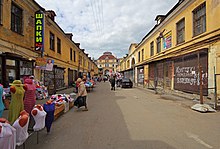Geronimo Corsini
Geronimo Corsini ( Russian Иероним Доминикович (Дементьевич) Корсини ; * 1808 in St. Petersburg ; † 1876 ) was a Russian architect .
Life
Corsini was the son of the artist Domenico Corsini , who came to St. Petersburg from Bologna in 1802 . He attended the German Annenschule in St. Petersburg and then the 2nd grammar school. He completed his studies at the St. Petersburg Military Engineering College in December 1830 as a Praporschtschik . He continued his education and carried out a number of remarkable buildings. Between 1831 and 1833 he built the Demidow House for workers in need of care on the Moika .
After 6 years in the military, Corsini took a leave of absence and from 1836 worked as a civil engineer in the office for state property of the St. Petersburg governorate and in the court director's office for state property. From 1838 he worked in the court management office of the ministry for the imperial court and in other ministries.
In addition to his work in the civil service, Corsini was 1837-1853 architect of Count Dmitri Nikolayevich Sheremetev . In 1837, Corsini built the cast iron grating in front of the Sheremetev Palace in St. Petersburg and a ball gallery in the palace and a dacha in Ulyanka on the Neva Bay . 1841-1842 he built the house of the Roman Catholic Stanislaus Church and 1845-1847 the house of the State Secretariat of the Kingdom of Poland .
In 1845 the Academy of Arts named Corsini a nominee academician . In 1849 he was elected a member of the Academy of Arts with the title of academician for his program for the planning of an aristocratic meeting house in the capital .
In the years 1851-1862 Corsini created various projects, including a building with rooms for a council for the Persian Shah and a mosque for the Turkish sultan . In 1853 Corsini rebuilt the main building of the Demidow House for workers in need of care and set up a house church in it. In 1856 he was involved in various building projects in St. Petersburg on the occasion of Alexander II's coronation . When the Apraxin -Hof on the Fontanka , on which almost all of St. Petersburg's second-hand bookshops were concentrated with the neighboring Shchukin-Hof , was largely destroyed during the St. Petersburg fire in May 1862 , Corsini drew up an overall plan for the reconstruction and built in Commissioned by Anton Stepanowitsch Apraxins from August 1862 to July 1863 on the Apraxin-Hof the row of shops on Alexandrowskaja Linija. Alexander Krakow built another row of shops .
Corsini was married to the writer Marija Antonowna Corsini nee Bystroglasowa and had two daughters and a son. The second daughter Natalja married the revolutionary Nikolai Issaakowitsch Utin .
Individual evidence
- ↑ a b c С. Н. Кондаков: Юбилейный справочник Императорской Академии художеств. 1764-1914. Т. 2 ( Часть биографическая) . Товарищество Р. Голике и А. Вильборг, St. Petersburg 1915, p. 344 ( [1] [accessed December 9, 2019]).
- ↑ a b c d e f Корсини, Иероним Доминикович . In: Русский биографический словарь А. А. Половцова . tape 9 , 1903, pp. 275 ( Wikisource [accessed December 9, 2019]).
- ↑ a b c d Russian Art Academy: КОРСИНИ Иероним Доменикович (1808–1876) (accessed December 10, 2019).
- ↑ Citywalls: Апраксин двор (accessed December 10, 2019).
| personal data | |
|---|---|
| SURNAME | Corsini, Geronimo |
| ALTERNATIVE NAMES | Корсини, Иероним Доминикович (Russian); Корсини, Иероним Дементьевич (Russian) |
| BRIEF DESCRIPTION | Russian architect |
| DATE OF BIRTH | 1808 |
| PLACE OF BIRTH | St. Petersburg |
| DATE OF DEATH | 1876 |

